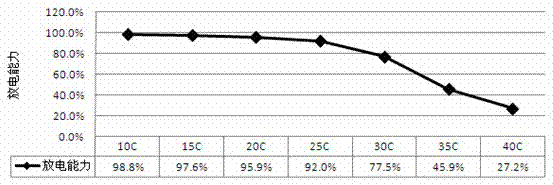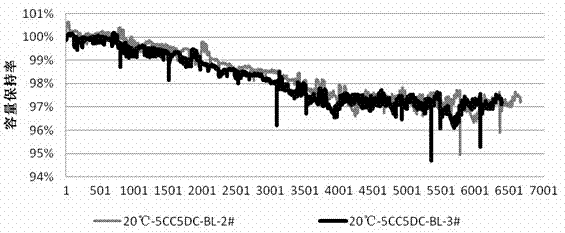Method for solving gas expansion failure of lithium titanate battery
A lithium titanate battery, flatulence technology, which is applied in the direction of electrical components, secondary batteries, secondary battery charging/discharging, etc., can solve the problems of flatulence failure of lithium titanate batteries, low probability of defective products, and high probability of defective products. , to achieve the effect of fast charging capability, low probability of defective products, and short processing cycle
- Summary
- Abstract
- Description
- Claims
- Application Information
AI Technical Summary
Problems solved by technology
Method used
Image
Examples
Embodiment 1
[0051] A method for solving the flatulence failure of a lithium titanate battery, which sequentially includes a formation process, an aging process and a vacuum packaging process, the formation process uses nickel-cobalt lithium manganese oxide / lithium manganate as the positive electrode material, and industrialized lithium titanate is the negative electrode The material, which is obtained through batching, coating, assembly, and electrolyte solution, is to be turned into a semi-finished battery cell, which includes the following steps in sequence:
[0052]Step 1: Charge with a constant current of 0.01C for 20h, where the cut-off voltage is 1.8V;
[0053] Step 2: Charge with a constant current of 0.1C for 7 hours, where the cut-off voltage is 2.8V;
[0054] Step 3: Charge with a constant current of 0.2C for 1 hour and then sleep for 5 minutes, where the cut-off voltage is 2.8V;
[0055] Step 4: Discharge at a constant current of 0.5C for 3 hours and then sleep for 5 minutes, ...
Embodiment 2
[0065] Step is with embodiment 1, and difference is:
[0066] In the chemical formation process,
[0067] Step 1: Charge with a constant current of 0.05C for 4 hours;
[0068] Step 2: Charge with a constant current of 0.1C for 2 hours;
[0069] Step 3: Charge with 0.3C constant current for 1 hour and then sleep for 5 minutes;
[0070] Step 7: Repeat steps 5 to 6 4 times and then sleep for 5 minutes;
[0071] Step 10: Repeat steps 8 to 9 4 times in a cycle;
[0072] In the aging process, the aging temperature is 60° C., and the aging time is 50 h.
[0073] In the vacuum packaging process, the vacuum inside the battery is -0.09MPa.
Embodiment 3
[0075] Step is with embodiment 1, and difference is:
[0076] In the chemical formation process,
[0077] Step 1: Charge with a constant current of 0.1C for 2 hours;
[0078] Step 2: Charge with a constant current of 0.2C for 1h;
[0079] Step 3: Charge with 0.5C constant current for 1 hour and then sleep for 5 minutes;
[0080] Step 7: Repeat steps 5 to 6 5 times and then sleep for 5 minutes;
[0081] Step 10: Repeat steps 8 to 9 5 times in a cycle;
[0082] In the aging process, the aging temperature is 65° C., and the aging time is 24 hours.
PUM
 Login to View More
Login to View More Abstract
Description
Claims
Application Information
 Login to View More
Login to View More - R&D
- Intellectual Property
- Life Sciences
- Materials
- Tech Scout
- Unparalleled Data Quality
- Higher Quality Content
- 60% Fewer Hallucinations
Browse by: Latest US Patents, China's latest patents, Technical Efficacy Thesaurus, Application Domain, Technology Topic, Popular Technical Reports.
© 2025 PatSnap. All rights reserved.Legal|Privacy policy|Modern Slavery Act Transparency Statement|Sitemap|About US| Contact US: help@patsnap.com



